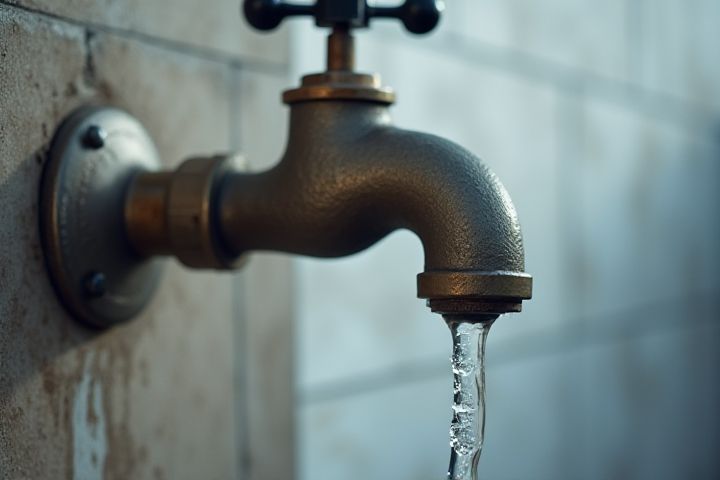
Low water pressure in your house can stem from several underlying issues. Clogged pipes often occur due to mineral buildup or debris, obstructing proper water flow and diminishing pressure. Leaks in the plumbing system might also contribute, as they can divert water away from reaching your faucets and fixtures. Additionally, an improperly adjusted pressure regulator can cause fluctuations in water pressure throughout your home. If your home uses a shared water supply, increased demand from neighbors may affect your available water pressure during peak usage times.
Why Does My House Have Low Water Pressure
Clogged pipes
Clogged pipes are a common cause of low water pressure in your house, as they restrict the flow of water through the plumbing system. Mineral deposits, grease, and other debris can accumulate over time, leading to blockages that impede water movement. This can result in uneven water pressure across faucets and showerheads, making daily tasks like bathing or washing dishes less efficient. Regular inspection and maintenance of your plumbing can help identify and resolve these clogs, ensuring optimal water flow throughout your home.
Faulty pressure regulator
A faulty pressure regulator can significantly impact your home's water pressure, often causing it to drop below optimal levels. This device is designed to maintain consistent water pressure by regulating incoming supply from the municipal system, which can reach pressures of 40-80 psi. If the pressure regulator malfunctions or becomes blocked, you might experience pressures as low as 30 psi or even less, leading to weak water flow in faucets and fixtures. Checking the regulator for signs of wear or corrosion can help identify the issue and improve your home's water pressure.
Leaking plumbing
Low water pressure in your house can often stem from leaking plumbing, which may be more significant than you realize. A staggering 10-15% of residential water usage can be attributed to leaks, resulting in not only water loss but also diminished pressure throughout your plumbing system. Over time, leaks can lead to corrosion and blockages, further exacerbating water pressure issues. Regular inspections can help identify these leaks early, helping you maintain optimal water flow and reduce unnecessary expenses.
Partially closed shut-off valves
Low water pressure in your house can often be traced back to partially closed shut-off valves. These valves, which regulate water flow from the main supply line, may not be fully opened, restricting the amount of water that can flow into your plumbing system. To address this, check the locations where shut-off valves are installed, such as near the water meter and under sinks, ensuring they are fully opened. By restoring these valves to their proper position, you can significantly improve your home's water pressure, enhancing your daily water usage experiences.
High water demand
Low water pressure in your house can often be attributed to high water demand, which occurs when multiple fixtures and appliances are used simultaneously, such as showers, washing machines, or dishwashers. This increased demand can overwhelm your plumbing system, especially if the pipes are narrow or outdated, leading to a noticeable decrease in pressure. Additionally, if your home is located at the end of a water line or in a region with high overall consumption, this can further impact water flow to your property. Understanding your household's water usage patterns can help identify peak times and allow for adjustments to minimize pressure drops.
Municipal water issues
Low water pressure in your house can often stem from municipal water supply issues, such as reduced flow rates due to aging infrastructure or increased demand during peak usage periods. Many municipalities experience fluctuations in water pressure, especially in densely populated areas, causing inadequate supply to individual homes. Moreover, local regulations and the management of the municipal water system can lead to pressure drops, particularly if there are ongoing repairs or maintenance work. In some instances, your home's plumbing might also contribute to low pressure, but addressing municipal concerns is often the first step to resolving this issue effectively.
Mineral deposits
Low water pressure in your house may be attributed to mineral deposits accumulating in pipes and fixtures over time. These deposits, often composed of calcium and magnesium carbonate, can restrict water flow, particularly in older plumbing systems. If your home uses hard water, the buildup could be significant, leading to pressure readings below the standard range of 40-60 psi. Regular maintenance, such as descaling or installing a water softener, can help alleviate the issue and improve your water pressure.
Corroded plumbing
Corroded plumbing significantly contributes to low water pressure in your house by restricting the flow of water. Over time, mineral buildup and rust can accumulate inside pipes, narrowing their diameter and impeding water movement. This corrosion not only reduces water pressure but can also lead to leaks, further compromising your plumbing system. Addressing corroded pipes through inspection and replacement can restore your home's water pressure and improve overall water quality.
Water heater issues
Low water pressure in your house can often be attributed to water heater issues. Over time, sediment buildup in the tank can obstruct water flow, causing inadequate pressure throughout your plumbing system. A malfunctioning pressure relief valve may also restrict water movement, leading to decreased water pressure. Regular maintenance and flushing of your water heater can help mitigate these problems, ensuring consistent water pressure for your home.
Airlock in pipes
Low water pressure in your house may stem from an airlock in the pipes. An airlock occurs when air becomes trapped in the plumbing system, disrupting the normal flow of water. This situation often arises in systems with high vertical lifts or where water supply is intermittent; the trapped air creates a barrier that significantly lowers downstream pressure. To resolve the issue, you can typically flush the airlock by opening all taps in your home and letting them run until the water flows steadily, expelling trapped air.
